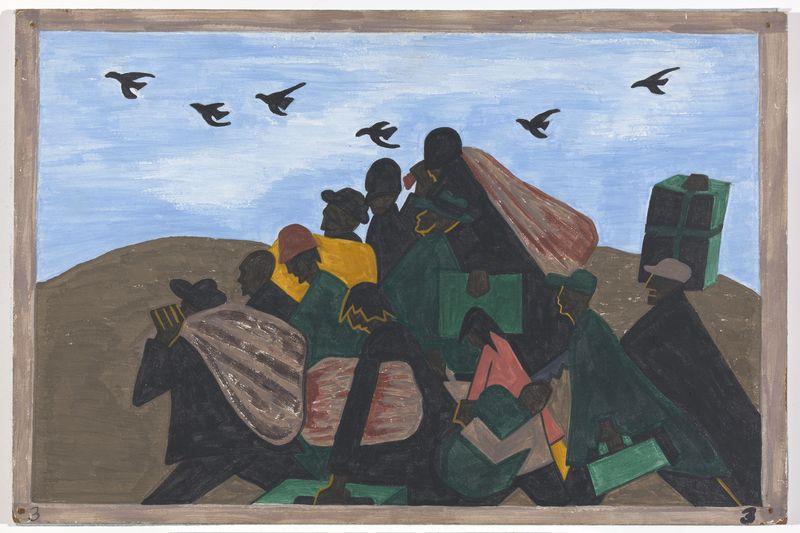What a new MoMA exhibit tells us about the history of American race relations
Panel 3: “In every town Negroes were leaving by the hundreds to go North and enter into Northern industry,” 1940-41. Casein tempera on hardboard, 18 x 12″.(Courtesy of MoMA)
From around World War I through the 1960s, there was a giant demographic shift in this country, which was as massive and consequential as the pioneers who rode wagon trains into the frontier a century earlier. Millions of black Americans in the rural South moved to the cities of the North in search of better living conditions and jobs.
African Americans escaped Jim Crow racism in the South, only to find racist cops, segregated housing and inequal schools in the North. We’re still dealing with the fallout today.
“This is a history that we collectively need to know,” says Leah Dickerman, a curator at the Museum of Modern Art who organized “One Way Ticket,” Jacob Lawrence’s Migration Series.
The Great Migration was massive, but at the time, it went largely unreported outside of black America. Artist Jacob Lawrence, however, who grew up in Atlantic City and Harlem in the 1920s and ‘30s, witnessed the movement first hand. He was just 23 when he made 60 paintings with captions that told the story of the movement. The “Migration Series” was immediately recognized as a masterpiece of modern art, and now it’s on display at the Museum of Modern Art.
Lawrence’s art and his interest in black history were born out of his teenage experiences with the artistic and political community he grew up in during Harlem’s renaissance.
“Out here are the black teachers, the librarians, the after-school sessions, and they would talk about Harriet Tubman, Frederick Douglass, Booker T. Washington. And it was told with such fervor. We grew up knowing about these heroes and that’s where it started,” Lawrence said in a 1990 interview.
Lawrence didn’t flinch from depicting the ugly parts of the Great Migration story. Now, 70 year later, his paintings are still relevant — and disturbingly familiar.
One painting at the exhibit depicts a scene that seems like it could be ripped from a modern-day headline.
“There is … a race riot in East St. Louis. In this battle scene, four black and white men go at each other with sticks, knives and bare fists. Limbs crisscross at angles so jagged, you can almost hear the chaos. One man is falling, his arm raised either in self defense or a plea for mercy as the white man standing over him takes aim with his club,” Studio 360's Christopher Johnson describes.
The Great Migration Series unfolds across 60 wood boards, 18"x12". The panels are arranged in a long row, reminiscent of a row of windows on a passenger train. One painting shows a crowd of black passengers lined up outside of a train station.
“In the ticket windows you see Chicago, New York, St. Louis — three of the great cities of the migration,” Dickerman says.
The Migration Series' run at the Museum of Modern Art concluded on Monday.
This story first aired as an story on PRI's Studio 360 with Kurt Andersen.
Our coverage reaches millions each week, but only a small fraction of listeners contribute to sustain our program. We still need 224 more people to donate $100 or $10/monthly to unlock our $67,000 match. Will you help us get there today?
